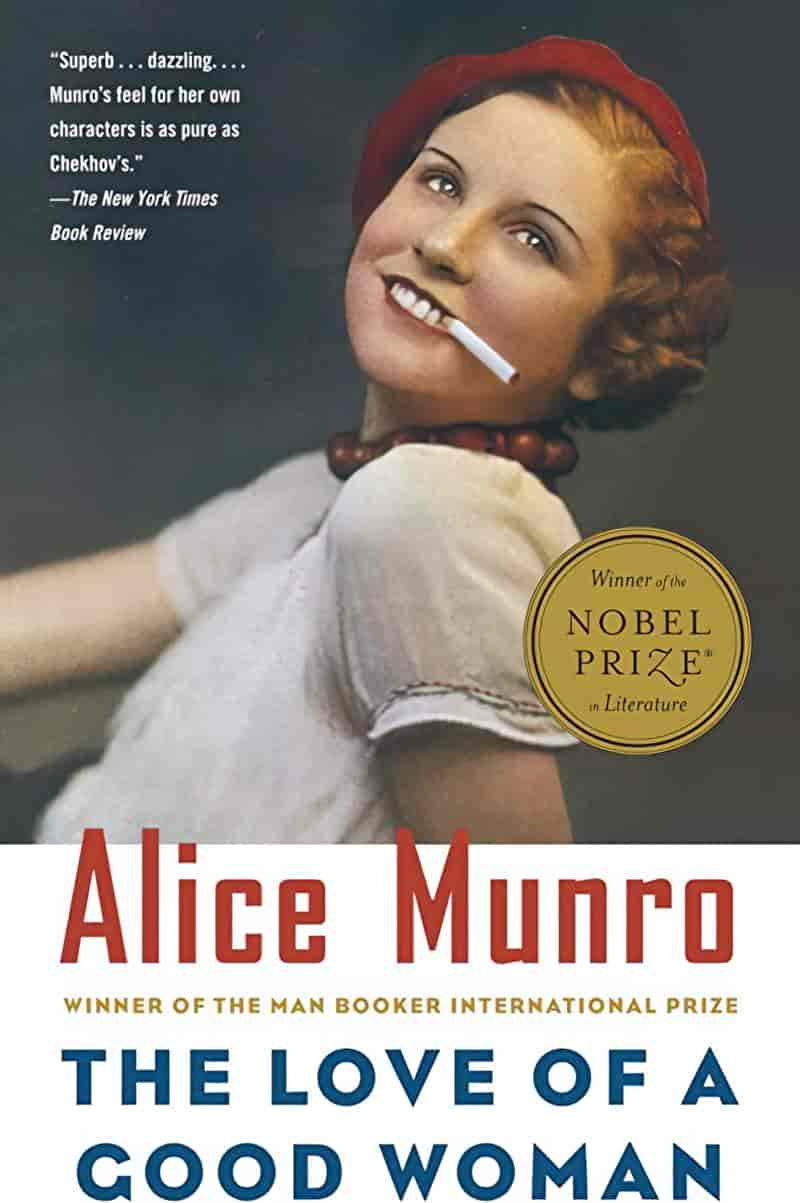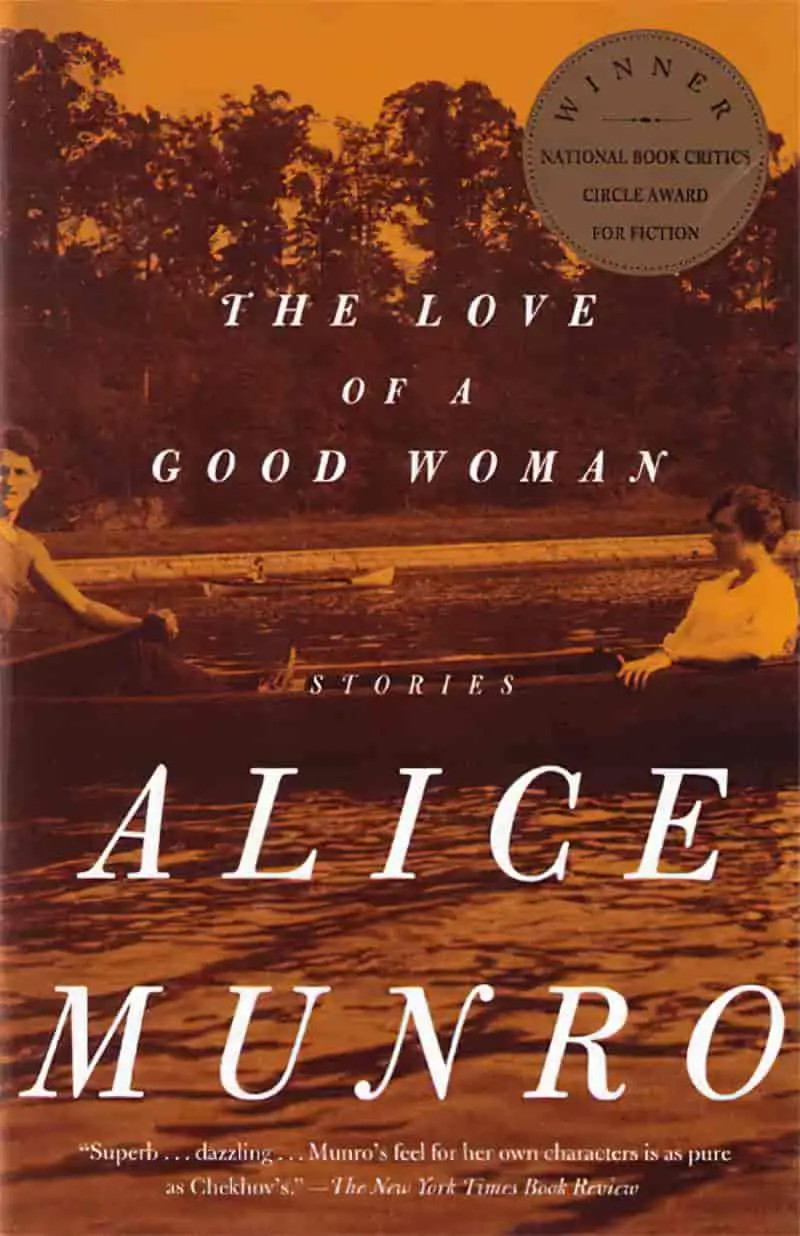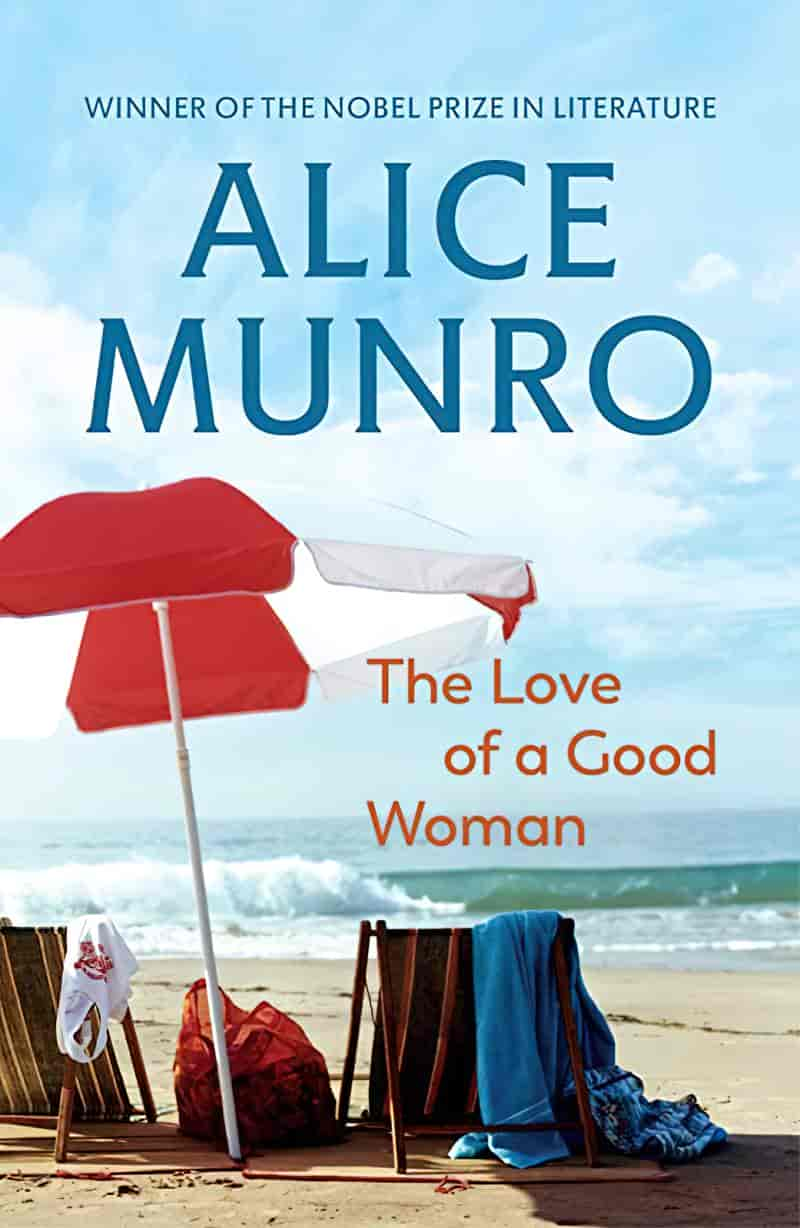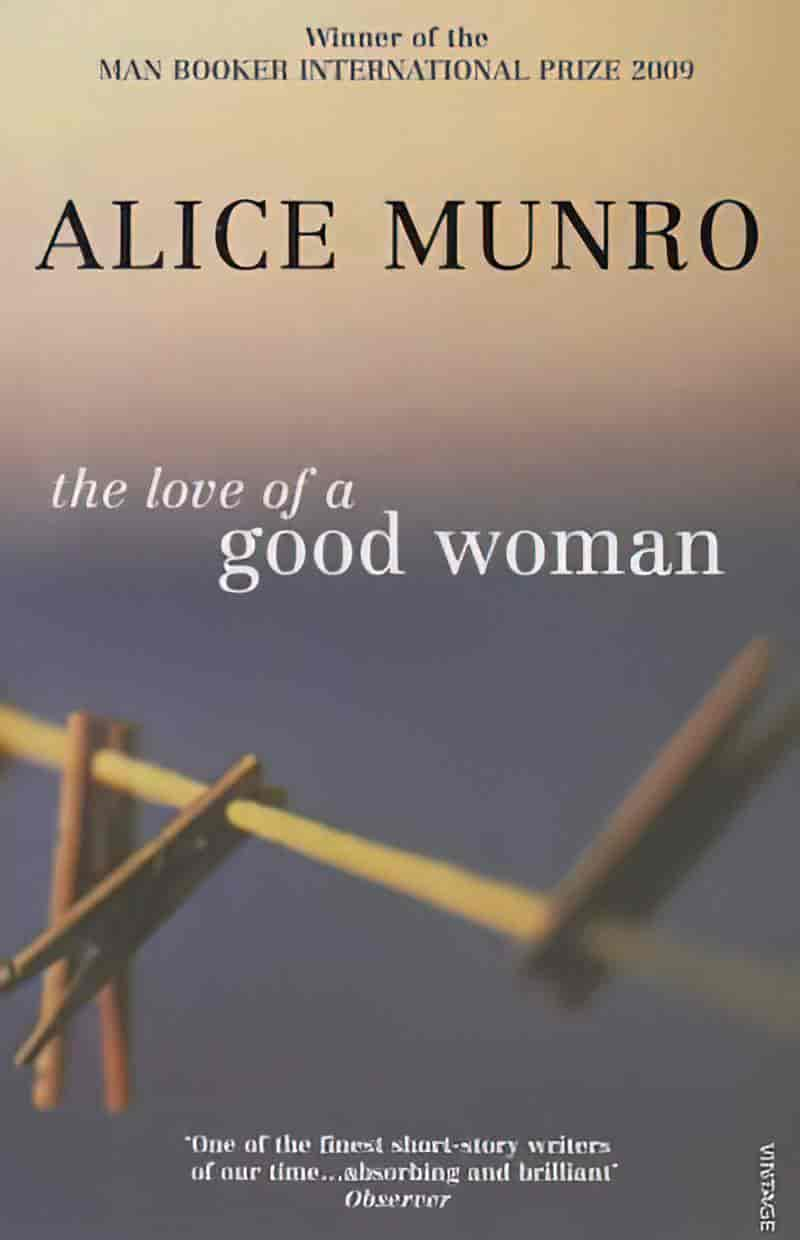“The Love Of A Good Woman” by Alice Munro is the title story in the collection which won the Nobel Prize in Literature, 2013. It’s a long short story — about 70 pages. We might even call it a novella, though let’s just go with this:
The title story of Alice Munro’s collection, The Love of a Good Woman, provides an illustrative “example of the difference between novelistic elaboration and short story mystery and intensity.”
from the introduction to The Art of Brevity edited by Per Winther, quoting Charles May
Although Munro has insisted in more than one place that she does not write as a “true novelist” does, many critics and reviewers have tried to give her fiction the dignity they think belongs only to the novel by suggesting that her stories are “novelistic” and therefore more complex than short stories. Dan Cryer in Newsday said the title story of The Love of a Good Woman “opens up an entire world and feels almost like a novel,” by which he seems to mean that Munro’s creation of a multiplicity of realistic details and numerous characters gives rise to more complexity than the short story does.
Charles May, Alice Munro 85th Birthday Tribute: Always True to the Short Story
THE LOVE OF A GOOD WOMAN (1998)
- “The Love Of A Good Woman” — a story revolving around a crime but not a crime story. Reminiscent of Stand By Me. Also in the December 23, 1996 edition of The New Yorker.
- “Jakarta” — not actually set in Jakarta. A story of an old woman whose husband went missing, and also about the so-called ‘free love’ of the 1960s, which afforded far more freedom to men.
- “Cortes Island” — a symbolic island standing in for the psychology of newly wed isolation. Also in the October 12, 1998 edition of The New Yorker.
- “Save The Reaper” — a re-visioning of Flannery O’Connor’s “A Good Man Is Hard To Find”. Also in the June 22, 1998 edition of The New Yorker.
- “The Children Stay” — What did divorce look and feel like when divorce was brand new? Also in the December 22, 1997 edition of The New Yorker.
- “Rich As Stink” — Focuses on an adolescent girl. Some commentators call her ‘precocious’ but I think she is a typical 11-year-old.
- “Before the Change” also in the August 24, 1998 edition of The New Yorker
- “My Mother’s Dream” — Critics don’t love this one, but I do. I read this short story as a commentary on how it takes a village to raise a child, and when any given mother doesn’t measure up as parent, other women can step in. Together, caregivers can band together to create a ‘whole’, and bring up a perfectly rounded and cared-for child, but alone? No. And we shouldn’t expect mothers to be perfect.




Here’s my best description of “The Love Of A Good Woman”: a literary Stand By Me, in which we never find out what happens, because the mystery is not the point.
- Both film and short story are set in the 1950s (Munro’s story in 1951; Stand By Me in 1959).
- Both feature a plot in which boys out on a day trip adventure aim to gain respect by (or after) finding a dead body.
- Both are set in a fictional small town where everyone knows everyone.
- Even in Stand By Me, the story is really about relationships rather than the dead body.
- Stand By Me is based on a Stephen King short story (called “The Body”). Both short stories feature dream sequences.
WHAT HAPPENS IN “THE LOVE OF A GOOD WOMAN”
The story begins with three boys finding the body of the town’s optometrist in his car submerged in the river. Although one might expect the plot immediately to focus on the mystery of the drowned man, Munro is in absolutely no hurry to satisfy the reader’s curiosity. She follows the three boys into their individual homes and leisurely explores their ordinary secretes. At the beginning of the next section of the story, Munro leaves the body and the boys altogether and focuses on a cranky dying woman, Mrs. Quinn, cared for by a lonely home nurse named Enid. Mrs Quinn tells Enid that Rupert, her husband, killed the optometrist when he saw him trying to fondle her.
When Mrs. Quinn dies, Enid, who cares for Rupert, decides she must tell him what she has heard and urge him to give himself up. The way she decides to do this, however, creates the open-ended ambiguity of the story: she asks him to row her out on the river, where she will tell him what she knows, also informing him that she cannot swim. At the last minute, she changes her mind but cannot escape the situation. the story ends just before they leave the shore, so the reader does not know whether Enid confronts Rupert and, if she does, whether he pushes her in the river or rows them both back to the shore.
“The Love Of A Good Woman” begins like a novel, but instead of continuing to broaden out, as it introduces new characters and seemingly new stories, it tightens up, slowly connecting what at first seemed disparate and unrelated. It is a classic example of Munro’s technique of creating a world that has all the illusion of external reality, while all the time pulling the reader deeper and deeper into what becomes a hallucinatory inner world of mystery, secrecy, and deception.
Charles E. May, The Art of Brevity
NARRATION
[Alice Munro] is so gentle though, so respectful. She doesn’t make that error that Katherine Mansfield stamped on in D.H. Lawrence of invading bodies and psyches as if we could ever understand others by magical omniscience rather than by empathy.
from a Goodreads reviewer
(I happen to be a Katherine Mansfield fan, but I see what the reviewer is talking about.)
CHARACTERS IN “THE LOVE OF A GOOD WOMAN”
Cece Ferns
Never tells his family anything. An only child. Older parents than usual. The older Cece Ferns is a heavy drinker and smoker. He abuses the son. It’s not clear if he abuses his wife or if the wife is suffering from another ailment. Cece has stepped into the role of carer.
Bud Salter
Called “Buddy” by adults (he doesn’t like that). Bud comes from a bustling nuclear family with older sisters who are in the throes of romance and teenage-hood, and a much younger brother. The mother is harried and the father is presumably at work. This household feels a bit like that depicted in Diary of a Wimpy Kid or Malcolm in the Middle. Far from ‘perfect’, but also very homely.
Jimmy Box
Jimmy lives with a huge extended family. His father is disabled after polio as a 22-year-old. He has a bicycle-repair shop in the shed behind the house. This is another bustling household a little similar to Bud’s, except the family seem to genuinely get along. In contrast to Bud’s self-absorbed older sisters, Jimmy’s sisters apologise whenever they bump into one another. And his father is as nice outside the home as he is in it.
Ralph Diller
Mentioned by name — another boy who could have easily been swapped out for any of the others. Not present for this particular discovery.
Mrs Willens
Is out in her garden, seemingly unaware that her optometrist husband is dead in the water.
Colonel Box
Related to Jimmy but slightly estranged.
Mr Pollock
Retired from the drugstore
Fergus Solley
‘Not a half-wit but looked like one’.
Captain Tervitt
Had been a real captain. Now special constable. Deaf and doesn’t normally wear hearing aids. Sleeps on the job but is nonetheless respected around town. A very prankable grown-up, in other words.
Enid
The home nurse for Mrs Quinn. Went to school with Rupert and was part of a group which bullied Rupert. Grew up next to Mr and Mrs Willens.
Mrs Quinn
Says she’s age 27, on her deathbed. Liver disease.
Mrs Olive Green
Mrs Quinn’s sister-in-law.
Rupert Quinn
Mrs Quinn’s husband, Olive Green’s husband. Tall. Potato Irish face. If he remembers Enid from school, he doesn’t let on.
Lois Quinn
Quinn daughter
Sylvie Quinn
Quinn daughter
STORY STRUCTURE OF “THE LOVE OF A GOOD WOMAN”
In its structural sophistication, richness of theme, and moral complexity, “The Love of a Good Woman” is one of the most thought provoking stories in Munro’s oeuvre, arguably her most ambitious achievement. In the two collections published in the first half of the 2000s, namely Hateship, Friendship, Courtship, Loveship, Marriage and Runaway, the writer continues to surprise and challenge readers, and scholars. Much in the fictive territory is familiar— the southwest Ontario settings; one narrator’s impulsive infidelity, another’s long- practiced aloofness— but the reader will notice some changes in the landscape.
Isla Duncan
SHORTCOMING
Clearly, Alice Munro has never been an adolescent boy herself. But I swear she’s been following a group of them round, somehow getting inside their heads. I’ve never been an adolescent boy either, but this feels like mimetic psychology.
These boys are stuck uncomfortably between being children and respected men in a patriarchal culture, expected to behave in a certain way — strong and stoic. This is their arch weakness.
Or perhaps their real shortcoming is this: They prematurely desire the respect and treatment of grown men when they don’t have the skill set to deal with the difficulties around that. If they could just relax and enjoy being children for a while longer, they wouldn’t have any problems. They could’ve simply told their parents about the body, after all. Alice Munro makes sure to explain why they didn’t do this, within the third person narration.
Enid is the main character of the other thread in this story. She is psychologically complex. Alice Munro understands that people behave differently according to the situation. Enid is a wonderfully kind, giving and self-sacrificial adult. Yet as a teenager she was on the wrong side of bullying. This describes many adults, I think. Munro does nothing basic. She doesn’t try to convince us that Enid’s utter goodness as an adult is all down to the guilt she feels about picking on Rupert in high school. This really is a matter of situational psychology. Prosocial people who are decent adult human beings can be drawn into the bullying system of high school due to those exact same sociable attributes.
DESIRE
The boys want to be taken seriously. But they also don’t want the responsibilities of adulthood just yet. In this particular story, this desire manifests across several competing wishes:
- To earn the prestige of having found a body.
- To run away from the confronting reality of death.
Via backstory we learn that Enid wanted to be a nurse. But because she belongs to a generation of girls who were never expected to have a job outside the home, she is cautioned against becoming a registered nurse. She instead becomes a practise nurse as it is supposedly less corrupting. She would obviously like to be useful and helpful.
OPPONENT
Who stands in the way of the boys being taken seriously?
Natal families tend to stand in the way of this, no matter how ‘good’ they are. The job of the adolescent is to bifurcate oneself from the natal home and establish an independent identity. The families themselves are therefore the boys’ Opponents, as well as all the adults around the town who treat them as boys, rather than as the respectable men they are hoping to be (prematurely).
The unseen opponent of the entire town is obviously whoever killed the optometrist. But this literary short story does not belong to the thriller/detective/murder mystery genres, and so Alice Munro is under no obligation to prioritise the importance of the murderer.
Who stands in the way of Enid’s wish to feel useful and helpful?
Mrs Quinn herself achieves this by being such an unpleasant patient. This provokes unwanted, unpleasant emotions in Enid that Enid would rather pretend she never experience. So Mrs Quinn is one of her Opponents.
Enid’s mother, too, is an Opponent because this is a woman who believes women of means should not be working, and certainly not working so hard. But because she is reliant as an adult upon the income of her natal family, Enid is in a similar situation to the boys who found the body — not fully realised as an independent person. For the boys this is because of their age; for Enid it is gender.
PLAN
As expected, due to their shortcoming and desire, the boys do a very responsible, adult thing by Planning to report the body to police. But when faced with the reality of the sergeant their younger selves win out, this time. They prank the old man and run away.
BIG STRUGGLE
Once the boys have pranked the deaf old man, they disappear from the story. For them, the Battle scene was the conversation at the police station.
The reader is shown the scene of the murder via a hypodiegetic section in which the narrator summarises what Mrs Quinn has told Enid.
ANAGNORISIS
Unlike the novel, which would be bound to develop some sort of satisfying closure, [“The Love Of A Good Woman”] reaches a moral impasse, an ambiguous, open end in which the reader suddenly realizes that instead of living in the world of apparent reality, he or she has been whirled, as if by a centrifugal force, to an almost unbearable central point of intensity.
Charles E. May, The Art of Brevity
To put it another way, this plot is shaped like a vortex.
How else can we explain by Alice Munro left us hanging like that? This is a story about truth vs reality, and reality is presented as unattainable. Via dreams and unreliable narrators (the sick and dying; the boys; and even Mr Quinn’s testimony, whose word would be so unreliable it’s not even worth us hearing it) we live out our lives and we all need to find the particular kind of humility in which we’ll never know the full truth of any situation. We are all unreliable narrators.
Notice how Munro has set this up.
She has included:
- Narration about how sick people often go through a phase of extreme pessimistic and lack of confidence, all out of whack with the reality of their sometimes very nice lives.
- Enid has these sex dreams which disturb her, but which she puts down to mind garbage.
- Enid has this false memory in which she sees her father sucking a woman’s breast. Some people mistakenly use the phrase ‘false memory syndrome‘. Avoid that, because it’s not a syndrome in the medical sense. False memories are so common that we should in fact consider them a natural mechanism of the human brain. Doesn’t everyone have a few of these? I remember walking around as a young kid at my nana’s motel. I encountered one of the cleaning ladies in the linen cupboard. Instead of saying hello, she pushed me right over to the ground before walking past me. The ‘memory’ is as vivid as any other from my preschool years, but I don’t believe it happened. I was far too clingy a child to be walking around the motel complex without my mother, for starters.
NEW SITUATION
The boys probably told someone about the dead body eventually, or perhaps someone else did. In any case, we never find out more about them. Their story feels a little like a McGuffin. But we can extrapolate what will happen to the boys, because Munro has given us enough to go on with Enid’s backstory, and the description of all the people who use the textbooks, and how people’s lives tend to go in this town after they finish their high school education.
We don’t know whether Enid lives or dies. We don’t know whether Mr Quinn committed the manslaughter. But what we do know is that Enid has reached the absolute pinnacle of self-sacrifice. Whatever happens out on that lake, she’ll never be the same again.
OTHER RESOURCES
Study Questions by Ronald Walker, retired Professor of English at Western Illinois University
“She is our Chekhov,” said Cynthia Ozick, “and she is going to outlast most of her contemporaries.” Ozick was talking about the great Alice Munro, the Canadian writer whose short stories about ordinary women and men have garnered every literary prize imaginable. In this episode, the first of three Alice Munro Week special episodes, Jacke introduces Part One of Munro’s masterpiece of a novella, “The Love of a Good Woman.”
History of Literature podcast, 1 Jun 2020

